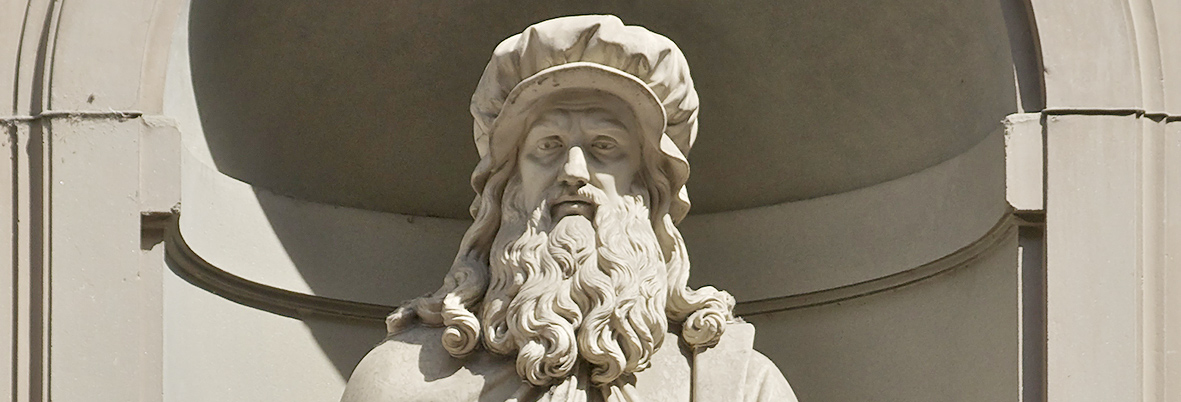达·芬奇和法国(Leonardo da Vinci and France)


莱昂纳多·达·芬奇的故居(The home of Leonardo da Vinci)1516 – 1519
1516年秋天,达芬奇(Leonardo da Vinci)到达了克洛斯城堡(Châteaudu ClosLucé),他唯一的住所。他今年64岁,是他从意大利来到法国定居的最后旅程。他从罗马带来了全部笔记本和素描以及他的三本杰作:“圣母与圣安妮之子”,“施洗者圣约翰”和“蒙娜丽莎”。这些作品仍然留在法国,现在存放在卢浮宫博物馆中。
In the Autumn of 1516, Leonardo da Vinci arrived at the Château du Clos Lucé, his only known residence. Aged 64, he undertook his final journey, coming from Italy to settle in France. From Rome, he brought the entirety of his notebooks and sketches as well as three of his masterpieces: "The Virgin and child with St. Anne", "St. John the Baptist" and the "Mona Lisa." These works still remain in France, now housed at the Louvre museum.

自1490年以来,法国国王的夏宫和查尔斯七世的玛努瓦·克洛(Manoir du Cloux)如今被称为克洛斯卢塞城堡(Châteaudu ClosLucé),1516年弗朗索瓦一世将其提供给达芬奇使用。
Summer residence of the kings of France since 1490, and of Charles VII, the Manoir du Cloux, today known by the name Château du Clos Lucé, was offered to da Vinci to use by François I in 1516.

列昂纳多·达·芬奇·弗朗索瓦一世的邀请:“国王的第一位画家,建筑师和工程师”(The invitation of François I, Leonardo da Vinci "the King's first painter, architect and engineer")
弗朗索瓦·我对达芬奇深表敬意,他称他为“我的父亲”。伟大的手工艺人和雕塑家本韦努托·切利尼(Benvenuto Cellini)也来自意大利。他说:“弗朗索瓦国王很欣赏他的高品质,他喜欢听他的讲话,除了他之外几乎找不到他……”
François I expressed a profound respect for da Vinci, who he called "my father". The great craftsman and sculptor Benvenuto Cellini, who had also come from Italy, said: "King François, who was so taken with his great qualities, loved to listen to him talk and was to hardly ever be found apart from him..."
达·芬奇在他的作品中把光的重要性归功于他:“看着光,欣赏光的美。闭上眼睛,然后再看一遍:你所看到的不再存在,以后再看到的还没有来成为。”
1517年10月10日,达芬奇在克洛斯卢塞(ClosLucé)接受了阿拉贡红衣主教的访问。据红衣主教秘书安东尼奥·比阿提斯(Antonio Beatis)的说法,莱昂纳多向他展示了一幅画,是“一位已故的朱利亚诺·德·美第奇(Giuliano de'Medici)请求从生活中描绘出的佛罗伦萨女士”。
Da Vinci attributed a great deal of importance to light in his works: "Look at light and admire its beauty. Close your eyes, and then look again: What you saw is no longer there, and what you will see later has not yet come to be."
On October 10, 1517, da Vinci received a visit from Cardinal d'Aragon at Clos Lucé. According to an account from Antonio Beatis, secretary to the cardinal, Leonardo presented him with a painting of "a Florentine lady painted from life at the request of the late Giuliano de' Medici."

蒙娜丽莎(Mona Lisa)
达芬奇(Leonardo da Vinci)于1503年或1504年开始在意大利佛罗伦萨绘画《蒙娜丽莎》。尽管卢浮宫说“在1503年和1506年之间毫无疑问地画过”,但是艺术史学家马丁·坎普说,要确定确切的日期还有些困难。根据莱昂纳多的当代人乔治·瓦萨里(Giorgio Vasari)的话,“他徘徊了四年之后,[他]未完成”。据说莱昂纳多一生的后悔是“从未完成任何一件事情”
。1516年,莱昂纳多受弗朗索瓦一世国王的邀请在安布瓦兹国王城堡附近的克洛斯卢塞工作。据信,他带了蒙娜丽莎,并在移居法国后继续工作。艺术史学家Carmen C.
他去世后,这幅画由他的学生和助手Salaì继承了其他作品。弗朗西斯·我(Francis I)以4,000埃库斯的价格购买了这幅画,并将其保存在枫丹白露宫(Palace of Fontainebleau),直到路易十四将画移至凡尔赛宫(Palace of Versailles)为止。法国大革命后,它被转移到卢浮宫,但在杜伊勒里宫的拿破仑的卧室里呆了一小段时间。
普法战争期间(1870-71年),它从卢浮宫迁至布列斯特阿森纳。在第二次世界大战期间,这幅画再次被从卢浮宫中移出,并安全地运到了昂布瓦斯城堡,然后又搬到Loc-Dieu修道院和尚博尔城堡,最后又搬到了蒙托邦的因格里斯博物馆。
据报道,2015年12月,法国科学家帕斯卡尔·科特(Pascal Cotte)使用反射光技术在这幅画的表面下发现了一张隐藏的肖像。肖像是从侧面看的模型的基础图像。在2004年,卢浮宫(Louvre)允许使用这幅画,科特(Cotte)用了十年的时间使用层放大方法研究这幅画。根据Cotte的说法,底层图像是Leonardo的原始《蒙娜丽莎》。
Leonardo da Vinci began painting the Mona Lisa in 1503 or 1504 in Florence, Italy. Although the Louvre states that it was "doubtless painted between 1503 and 1506", the art historian Martin Kemp says there are some difficulties in confirming the actual dates with certainty. According to Leonardo's contemporary, Giorgio Vasari, "after he had lingered over it four years, [he] left it unfinished". Leonardo, later in his life, is said to have regretted "never having completed a single work"
In 1516, Leonardo was invited by King François I to work at the Clos Lucé near the king's castle in Amboise. It is believed that he took the Mona Lisa with him and continued to work after he moved to France. Art historian Carmen C. Bambach has concluded that da Vinci probably continued refining the work until 1516 or 1517.
Upon his death, the painting was inherited with other works by his pupil and assistant Salaì. Francis I bought the painting for 4,000 écus and kept it at Palace of Fontainebleau, where it remained until Louis XIV moved the painting to the Palace of Versailles. After the French Revolution, it was moved to the Louvre, but spent a brief period in the bedroom of Napoleon in the Tuileries Palace.
During the Franco-Prussian War (1870–71) it was moved from the Louvre to the Brest Arsenal. During World War II, the painting was again removed from the Louvre and taken safely, first to Château d'Amboise, then to the Loc-Dieu Abbey and Château de Chambord, then finally to the Ingres Museum in Montauban.
In December 2015, it was reported that French scientist Pascal Cotte had found a hidden portrait underneath the surface of the painting using reflective light technology. The portrait is an underlying image of a model looking off to the side. Having been given access to the painting by Louvre in 2004, Cotte spent ten years using layer amplification methods to study the painting. According to Cotte, the underlying image is Leonardo's original Mona Lisa.
如今,蒙娜丽莎已被认为是世界上最著名的画作,但是直到20世纪,蒙娜丽莎才是众多画中的一员,而不是现在所说的“最著名的画作”。蒙娜丽莎曾经是国王的收藏品之一,是卢浮宫展出的第一批艺术品之一,卢浮宫在法国大革命后成为国家博物馆。从19世纪开始,莱昂纳多(Leonardo)开始被人们视为天才,从19世纪中叶起,法国知识分子提出了主题:油画神秘而又代表着女性的致命性。1878年,《 Baedeker》指南将其称为“卢浮宫里莱昂纳多最著名的作品”。但是知识精英比普通大众更了解它。
美国总统约翰·肯尼迪,玛德琳·马尔洛,安德烈·马尔洛,杰奎琳·肯尼迪和林登·约翰逊在1963
年1月8日访问华盛顿特区期间在国家艺术馆的《蒙娜丽莎》揭幕仪式上展出。1911年的盗窃及随后的归还世界各地都有报道,导致公众对这幅画的认可度大大提高。在20世纪,它是大量复制,销售,讽刺和投机的对象,据称已被复制为“ 300幅绘画和2,000个广告”。
Today the Mona Lisa is considered the most famous painting in the world, but until the 20th century, Mona Lisa was one among many and not the "most famous painting" as it is now termed. Once part of the king's collection, the Mona Lisa was among the very first artworks to be exhibited in Louvre, which became a national museum after the French Revolution. From the 19th century Leonardo began to be revered as a genius and the painting's popularity grew from the middle of the 19th century when French intelligentsia developed a theme that the painting was somehow mysterious and a representation of the femme fatal. In 1878, the Baedeker guide called it "the most celebrated work of Leonardo in the Louvre". but it was known more by the intellectual elite than the general public.
US President John F. Kennedy, Madeleine Malraux, André Malraux, Jacqueline Kennedy and Lyndon B. Johnson at the unveiling of the Mona Lisa at the National Gallery of Art during its visit to Washington D.C., 8 January 1963
The 1911 theft and the subsequent return was reported worldwide, leading to a massive increase in public recognition of the painting. During the 20th century it was an object for mass reproduction, merchandising, lampooning and speculation, and was claimed to have been reproduced in "300 paintings and 2,000 advertisements".
罗浮宫博物馆(Musée du Louvre)
1962年12月至1963年3月,法国政府将其借给美国,在纽约市和华盛顿特区进行展示。该船被装在新的SS法国邮轮上。在纽约,估计有170万人排队等候,“目的是使蒙娜·丽莎(Mona Lisa)一览20秒钟左右”。1974年,这幅画在东京和莫斯科展出。
2014年,有930万人参观了卢浮宫,导演亨利·洛雷特(Henri Loyrette)估计“ 80%的人只想见蒙娜丽莎”。
From December 1962 to March 1963, the French government lent it to the United States to be displayed in New York City and Washington, D.C. It was shipped on the new liner SS France. In New York an estimated 1.7 million people queued "in order to cast a glance at the Mona Lisa for 20 seconds or so." In 1974, the painting was exhibited in Tokyo and Moscow.
In 2014, 9.3 million people visited the Louvre, Former director Henri Loyrette reckoned that "80 percent of the people only want to see the Mona Lisa."


